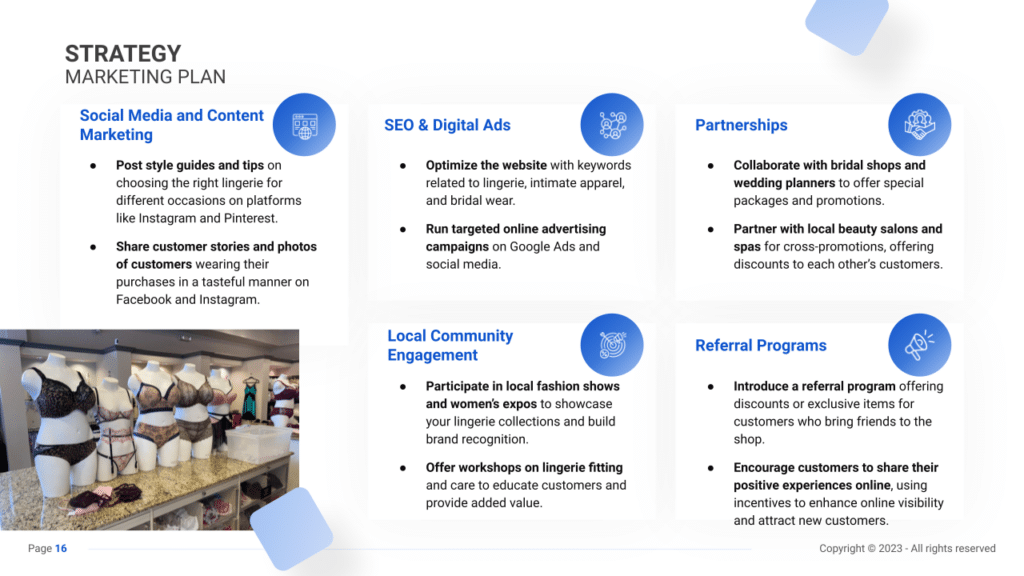Lingerie Shop Business Plan Template & PDF Example

Creating a comprehensive business plan is crucial for launching and running a successful lingerie shop. This plan serves as your roadmap, detailing your vision, operational strategies, and financial plan. It helps establish your lingerie shop business’s identity, navigate the competitive market, and secure funding for growth.
This article not only breaks down the critical components of a lingerie shop business plan, but also provides an example of a business plan to help you craft your own.
Whether you’re an experienced entrepreneur or new to the retail industry, this guide, complete with a business plan example, lays the groundwork for turning your lingerie shop business concept into reality. Let’s dive in!
The Plan
Our lingerie shop business plan is structured to cover all essential aspects needed for a comprehensive strategy. It outlines the store’s operations, marketing strategy, market environment, competitors, management team, and financial forecasts.
- Executive Summary: Offers an overview of your lingerie shop’s business concept, market analysis, management, and financial strategy.
- Business Overview: Provides detailed information on what your lingerie shop offers and its operational model:
- Store & Location: Describes the store’s design, amenities, and why its location is appealing to potential clients.
- Supply & Products: Lists the types of lingerie and related products provided by your store, including pricing structure.
- Market Overview: Examines the lingerie shop industry landscape, identifying competitors and how your store stands out:
- Key Stats: Shares industry size, growth trends, and relevant statistics for the lingerie market.
- Key Trends: Highlights recent trends affecting the lingerie sector.
- Key Competitors: Analyzes main competitors nearby and how your lingerie shop differs from them.
- Strategy: Outlines how the lingerie shop intends to achieve growth and attract clients:
- SWOT Analysis: Strengths, weaknesses, opportunities, and threats analysis.
- Marketing Plan: Strategies for attracting and retaining customers.
- Timeline: Key milestones and objectives from start-up through the first year of operation.
- Management: Information on who manages the lingerie shop and their roles.
- Financial Plan: Projects the store’s 5-year financial performance, including revenue, profits, and expected expenses.

Executive Summary
The Executive Summary introduces your lingerie shop’s business plan, offering a concise overview of your shop and its services. It should detail your market positioning, the range of lingerie and intimate apparel you offer, its location, size, and an outline of day-to-day operations.
This section should also explore how your lingerie shop will integrate into the local market, including the number of direct competitors within the area, identifying who they are, along with your shop’s unique selling points that differentiate it from these competitors.
Furthermore, you should include information about the management and co-founding team, detailing their roles and contributions to the shop’s success. Additionally, a summary of your financial projections, including revenue and profits over the next five years, should be presented here to provide a clear picture of your shop’s financial plan.
Business Overview
For a Lingerie Shop, the Business Overview section can be concisely divided into 2 main slides:
Store & Location
Describe the shop’s design, comfort, and welcoming atmosphere. Highlight the advantageous location, emphasizing accessibility, proximity to shopping centers, and ease of parking, which attract your target clientele. Mention how the layout and decor align with the brand’s image.
Supply & Products
Detail the range of lingerie and intimate apparel, including bras, panties, sleepwear, and loungewear. Highlight exclusive brands or products. Outline a pricing strategy reflecting quality and market alignment. Mention special collections, custom fitting services, membership deals, and loyalty programs to encourage repeat business.
Market Overview

Industry Size & Growth
In the Market Overview of your lingerie shop business plan, start by examining the size of the lingerie industry and its growth potential. This analysis is crucial for understanding the market’s scope and identifying expansion opportunities.
Key Market Trends
Proceed to discuss recent market trends, such as the increasing consumer interest in personalized lingerie fittings, sustainable and ethically produced lingerie, and the rise of online shopping for intimate apparel. Highlight the demand for diverse size ranges, comfortable yet stylish designs, and eco-friendly materials.
Competitive Landscape
A competitive analysis is not just a tool for gauging the position of your lingerie shop in the market and its key competitors; it’s also a fundamental component of your business plan.
This analysis helps in identifying your lingerie shop’s unique selling points, essential for differentiating your business in a competitive market.
In addition, the competitive analysis is integral in laying a solid foundation for your business plan. By examining various operational aspects of your competitors, you gain valuable information that ensures your business plan is robust, informed, and tailored to succeed in the current market environment.
Identifying Your Competitors in the Lingerie Industry
Identifying competitors is the first step in understanding your position in the lingerie market. Begin by mapping out local lingerie shops and large retail chains. For instance, if your shop specializes in luxury lingerie, your direct competitors include nearby boutiques known for their premium products, as well as larger retailers that offer a wide range of lingerie options. Don’t overlook indirect competitors such as department stores and online retailers that offer extensive lingerie collections.
Use online tools like Google Maps to get a geographical sense of competitor distribution. Platforms like Yelp and TripAdvisor offer customer reviews and ratings, providing insights into competitors’ strengths and weaknesses. For example, if several reviews commend the quality and fit of products at “Elegance Lingerie,” this is a key strength of your competitor.

Lingerie Shop Competitors’ Strategies
Analyzing the strategies of these competitors involves several aspects:
- Product Range: Examine their range of lingerie. If “EcoLuxe Lingerie” is gaining popularity with its sustainable and eco-friendly products, it indicates a market trend toward ethically conscious consumers.
- Merchandising: Consider the merchandising and display techniques. A shop like “Glamour Intimates” that focuses on luxurious, visually appealing displays might attract customers looking for a premium shopping experience, while “Comfort First” might appeal to those looking for practical, everyday lingerie.
- Pricing Strategy: Compare your prices with those of competitors. Are your lingerie items priced similarly to “Value Lace” or are they more aligned with the premium offerings at “Luxury Lingerie Boutique”?
- Marketing Tactics: Look at how competitors market their products. Do they have a strong online presence with active social media accounts and influencer partnerships, or do they rely more on local community events and in-store promotions?
- Customer Experience: Assess the in-store experience. For instance, “Intimate Essentials” might be known for its personalized fitting services and knowledgeable staff, enhancing the shopping experience.
- Operational Efficiency: Observe if competitors are using technology or innovative processes to streamline shopping and purchasing, such as “TechSavvy Intimates” with its online appointment booking for fittings and virtual try-on features.
What’s Your Lingerie Shop’s Value Proposition?
Reflect on your shop’s unique value proposition. Maybe your lingerie shop is known for its exclusive designer collections, or perhaps you offer a unique range of custom-fit lingerie that isn’t available elsewhere in your area.
Identify market gaps through customer feedback and industry trends. For example, the growing interest in sustainable and ethically-made lingerie could represent a market opportunity if competitors are not addressing this demand.
Consider your location: A lingerie shop in a busy urban area might focus on trendy, fashionable items for a diverse customer base, while a shop in a suburban neighborhood could capitalize on offering a wide range of sizes and styles for everyday wear.
Strategy

SWOT
First, conduct a SWOT analysis for the lingerie shop, highlighting Strengths (such as high-quality and exclusive lingerie products), Weaknesses (including high operational costs or dependency on seasonal sales), Opportunities (for example, growing consumer demand for sustainable and ethically produced lingerie), and Threats (such as economic downturns that may decrease consumer spending on luxury items).

Marketing Plan
Next, develop a marketing strategy that outlines how to attract and retain clients through targeted advertising, promotional discounts, engaging social media presence, and community involvement.
Marketing Channels
The various marketing channels for a lingerie shop are crucial avenues for communicating your brand and services to both potential and existing customers.
Digital Marketing
In today’s digital era, a robust online presence is paramount for brand visibility and customer engagement.
- Social Media: Utilize Instagram to showcase diverse lingerie collections, create engaging stories on Facebook, and use Pinterest to highlight trendsetting designs. Consistent engagement through comments and direct messages is key.
- Email Marketing: Build an email subscriber list by offering discounts for sign-ups. Send regular newsletters featuring styling tips, exclusive offers, and updates about new arrivals to keep customers engaged.
- Website and SEO: Develop a professional and user-friendly website showcasing your lingerie collections, customer testimonials, and a blog featuring fashion advice. Optimize your website for local SEO to boost visibility in searches for lingerie in your area.
Local Advertising
Connect with your local community for increased visibility:
- Print Media and Flyers: Advertise in local publications and distribute eye-catching flyers in strategic locations frequented by your target audience.
- Community Engagement: Participate in local events, sponsor fashion shows, and collaborate with fitness centers or beauty-related businesses for cross-promotional events.
Promotional Activities
Incentivize customers and entice new ones through compelling offers and loyalty programs:
- Seasonal Promotions: Launch themed collections or offer discounts during festive seasons, leveraging occasions like Valentine’s Day or bridal showcases.
- Loyalty Programs and Referral Incentives: Encourage repeat business by introducing loyalty cards, membership perks, and referral bonuses.

Sales Channels
In-Store Experience
Enhance the customer journey with personalized service and upselling opportunities:
- Personalized Fittings: Train staff to offer expert advice and personalized fitting consultations to elevate the shopping experience.
- Upselling and Add-Ons: Suggest complementary lingerie pieces or accessories to enhance each purchase.
Online Sales and Services
Leverage technology to broaden your sales horizon:
- E-Commerce Platform: Develop a user-friendly online shopping experience offering a diverse range of lingerie styles and collections.
- Virtual Styling Consultations: Offer online consultations for personalized lingerie recommendations, catering to individual preferences and body types.
Membership and Rewards Programs
Foster long-term customer relationships through loyalty programs:
- Subscription Services: Introduce subscription boxes or membership options for curated lingerie sets delivered periodically.
- Tiered Loyalty Rewards: Implement tiered rewards systems offering escalating benefits for higher-tier members based on purchase levels.
Continued Growth and Adaptation
To ensure continual success, adaptability, and ongoing assessment are key:
- Monitoring KPIs: Regularly track and analyze key performance indicators such as sales growth, website traffic, conversion rates, and customer engagement across various marketing channels.
- Customer Feedback: Solicit and utilize customer feedback to refine offerings, services, and marketing strategies.
- Market Trends: Stay abreast of emerging trends within the lingerie industry, swiftly adapting to changing consumer demands and preferences.
Strategy Timeline
Finally, create a detailed timeline that outlines critical milestones for the lingerie shop’s opening, marketing efforts, client base growth, and expansion objectives, ensuring the business moves forward with clear direction and purpose.

Management
The Management section focuses on the lingerie shop business’s management and their direct roles in daily operations and strategic direction. This part is crucial for understanding who is responsible for making key decisions and driving the lingerie shop business toward its financial and operational goals.
For your lingerie shop business plan, list the core team members, their specific responsibilities, and how their expertise supports the business.


Financial Plan
The Financial Plan section is a comprehensive analysis of your financial projections for revenue, expenses, and profitability. It lays out your lingerie shop business’s approach to securing funding, managing cash flow, and achieving breakeven.
This section typically includes detailed forecasts for the first 5 years of operation, highlighting expected revenue, operating costs and capital expenditures.
For your lingerie shop business plan, provide a snapshot of your financial statement (profit and loss, balance sheet, cash flow statement), as well as your key assumptions (e.g. number of customers and prices, expenses, etc.).
Make sure to cover here
_ Profit and Loss
_ Cash Flow Statement
_ Balance Sheet
_ Use of Funds









